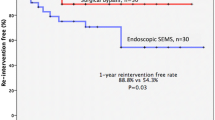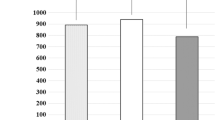Abstract
Background
Although self-expandable metal stents (SEMS) are widely used for distal malignant biliary obstruction, one-step SEMS (direct placement without a prior plastic stent) and two-step SEMS (placement at second endoscopic retrograde cholangiopancreatography [ERCP] following plastic stent placement) have not been fully compared.
Methods
In this multicenter retrospective study, patients were included who underwent first-time endoscopic SEMS placement between September 1994 and December 2010. We compared the one-step and two-step strategies using a propensity analysis.
Results
In total, 370 patients were identified and one-step SEMS was performed in 59 patients. After adjustment using propensity scores, the median times to dysfunction were 116 and 219 days, respectively, for one-step and two-step SEMS (P = 0.058). Stent migration was more frequently observed in one-step SEMS as compared with two-step SEMS (25 vs. 11 %, P = 0.031). In one-step SEMS, the number of days of hospitalization associated with first-time SEMS placement was shorter compared with that in two-step SEMS (21 vs. 30 days, P = 0.001), and the total costs of SEMS-related interventions within 6 months were lower (6510 and 8100 USD, P = 0.004). The pathological diagnosis rates for pancreatic and biliary tract cancer at initial ERCP were 52 and 61 %. After failed diagnosis at initial ERCP, pathological diagnosis rates for pancreatic cancer were 32 versus 76 % (P = 0.005) by repeated ERCP versus endoscopic ultrasound (EUS)-guided fine-needle aspiration (FNA).
Conclusions
One-step SEMS was associated with increased stent migration, despite having potential cost-effectiveness. The additional yield of pathological diagnosis at repeated ERCP was low compared with that yielded by EUS-guided FNA.



Similar content being viewed by others
References
Davids P, Groen A, Rauws E, Tytgat G, Huibregtse K. Randomised trial of self-expanding metal stents versus polyethylene stents for distal malignant biliary obstruction. Lancet. 1992;340:1488–92.
Knyrim K, Wagner H, Pausch J, Vakil N. A prospective, randomized, controlled trial of metal stents for malignant obstruction of the common bile duct. Endoscopy. 1993;25:207–12.
Lammer J, Hausegger K, Flückiger F, Winkelbauer F, Wildling R, Klein G, et al. Common bile duct obstruction due to malignancy: treatment with plastic versus metal stents. Radiology. 1996;201:167–72.
Isayama H, Yasuda I, Ryozawa S, Maguchi H, Igarashi Y, Matsuyama Y, et al. Results of a Japanese multicenter, randomized trial of endoscopic stenting for non-resectable pancreatic head cancer (JM-test): covered Wallstent versus doublelayer stent. Dig Endosc. 2011;23:310–5.
Erickson RA, Garza AA. EUS with EUS-guided fine-needle aspiration as the first endoscopic test for the evaluation of obstructive jaundice. Gastrointest Endosc. 2001;53:475–84.
Gress F, Gottlieb K, Sherman S, Lehman G. Endoscopic ultrasonography-guided fine-needle aspiration biopsy of suspected pancreatic cancer. Ann Intern Med. 2001;134:459–64.
Eloubeidi MA, Chen VK, Eltoum IA, Jhala D, Chhieng DC, Jhala N, et al. Endoscopic ultrasound-guided fine needle aspiration biopsy of patients with suspected pancreatic cancer: diagnostic accuracy and acute and 30-day complications. Am J Gastroenterol. 2003;98:2663–8.
Mansfield SD, Scott J, Oppong K, Richardson DL, Sen G, Jaques BC, et al. Comparison of multislice computed tomography and endoscopic ultrasonography with operative and histological findings in suspected pancreatic and periampullary malignancy. Br J Surg. 2008;95:1512–20.
Dewitt J, Devereaux BM, Lehman GA, Sherman S, Imperiale TF. Comparison of endoscopic ultrasound and computed tomography for the preoperative evaluation of pancreatic cancer: a systematic review. Clin Gastroenterol Hepatol. 2006;4:717–25 (quiz 664).
Park HS, Lee JM, Choi HK, Hong SH, Han JK, Choi BI. Preoperative evaluation of pancreatic cancer: comparison of gadolinium-enhanced dynamic MRI with MR cholangiopancreatography versus MDCT. J Magn Reson Imaging. 2009;30:586–95.
Enya M, Yasuda I, Mukai T, Shinoda T, Otsuji K, Iwasa J, et al. Endoscopic treatment for benign biliary strictures: can placement of a covered metallic stent be an option in refractory cases? Dig Endosc. 2004;16:12–20.
Kahaleh M, Tokar J, Le T, Yeaton P. Removal of self-expandable metallic Wallstents. Gastrointest Endosc. 2004;60:640–4.
Familiari P, Bulajic M, Mutignani M, Lee LS, Spera G, Spada C, et al. Endoscopic removal of malfunctioning biliary self-expandable metallic stents. Gastrointest Endosc. 2005;62:903–10.
Park do H, Kim MH, Moon SH, Lee SS, Seo DW, Lee SK. Feasibility and safety of placement of a newly designed, fully covered self-expandable metal stent for refractory benign pancreatic ductal strictures: a pilot study (with video). Gastrointest Endosc. 2008;68:1182–9.
Baron TH, Poterucha JJ. Insertion and removal of covered expandable metal stents for closure of complex biliary leaks. Clin Gastroenterol Hepatol. 2006;4:381–6.
Kahaleh M, Brock A, Conaway MR, Shami VM, Dumonceau JM, Northup PG, et al. Covered self-expandable metal stents in pancreatic malignancy regardless of resectability: a new concept validated by a decision analysis. Endoscopy. 2007;39:319–24.
Schmassmann A, von Gunten E, Knuchel J, Scheurer U, Fehr H, Halter F. Wallstents versus plastic stents in malignant biliary obstruction: effects of stent patency of the first and second stent on patient compliance and survival. Am J Gastroenterol. 1996;91:654–9.
Menon K, Romagnuolo J, Barkun A. Expandable metal biliary stenting in patients with recurrent premature polyethylene stent occlusion. Am J Gastroenterol. 2001;96:1435–40.
Artifon EL, Sakai P, Ishioka S, Marques SB, Lino AS, Cunha JE, et al. Endoscopic sphincterotomy before deployment of covered metal stent is associated with greater complication rate: a prospective randomized control trial. J Clin Gastroenterol. 2008;42:815–9.
Joffe MM, Rosenbaum PR. Invited commentary: propensity scores. Am J Epidemiol. 1999;150:327–33.
D’Agostino RB Jr. Propensity score methods for bias reduction in the comparison of a treatment to a non-randomized control group. Stat Med. 1998;17:2265–81.
Telford JJ, Carr-Locke DL, Baron TH, Poneros JM, Bounds BC, Kelsey PB, et al. A randomized trial comparing uncovered and partially covered self-expandable metal stents in the palliation of distal malignant biliary obstruction. Gastrointest Endosc. 2010;72:907–14.
Kullman E, Frozanpor F, Söderlund C, Linder S, Sandström P, Lindhoff-Larsson A, et al. Covered versus uncovered self-expandable nitinol stents in the palliative treatment of malignant distal biliary obstruction: results from a randomized, multicenter study. Gastrointest Endosc. 2010;72:915–23.
Isayama H, Komatsu Y, Tsujino T, Yoshida H, Tada M, Shiratori Y, et al. Polyurethane-covered metal stent for management of distal malignant biliary obstruction. Gastrointest Endosc. 2002;55:366–70.
Isayama H, Komatsu Y, Tsujino T, Sasahira N, Hirano K, Toda N, et al. A prospective randomised study of “covered” versus “uncovered” diamond stents for the management of distal malignant biliary obstruction. Gut. 2004;53:729–34.
Nakai Y, Isayama H, Komatsu Y, Tsujino T, Toda N, Sasahira N, et al. Efficacy and safety of the covered Wallstent in patients with distal malignant biliary obstruction. Gastrointest Endosc. 2005;62:742–8.
Saleem A, Leggett CL, Murad MH, Baron TH. Meta-analysis of randomized trials comparing the patency of covered and uncovered self-expandable metal stents for palliation of distal malignant bile duct obstruction. Gastrointest Endosc. 2011.
Coene P, Groen A, Cheng J, Out M, Tytgat G, Huibregtse K. Clogging of biliary endoprostheses: a new perspective. Gut. 1990;31:913–7.
Weickert U, Venzke T, König J, Janssen J, Remberger K, Greiner L. Why do bilioduodenal plastic stents become occluded? A clinical and pathological investigation on 100 consecutive patients. Endoscopy. 2001;33:786–90.
Leung J, Liu Y, Chan R, Tang Y, Mina Y, Cheng A, et al. Early attachment of anaerobic bacteria may play an important role in biliary stent blockage. Gastrointest Endosc. 2000;52:725–9.
Foutch P, Kerr D, Harlan J, Kummet T. A prospective, controlled analysis of endoscopic cytotechniques for diagnosis of malignant biliary strictures. Am J Gastroenterol. 1991;86:577–80.
Pugliese V, Conio M, Nicolo G, Saccomanno S, Gatteschi B. Endoscopic retrograde forceps biopsy and brush cytology of biliary strictures: a prospective study. Gastrointest Endosc. 1995;42:520–6.
Schoefl R, Haefner M, Wrba F, Pfeffel F, Stain C, Poetzi R, et al. Forceps biopsy and brush cytology during endoscopic retrograde cholangiopancreatography for the diagnosis of biliary stenoses. Scand J Gastroenterol. 1997;32:363–8.
de Bellis M, Sherman S, Fogel EL, Cramer H, Chappo J, McHenry L Jr, et al. Tissue sampling at ERCP in suspected malignant biliary strictures (part 2). Gastrointest Endosc. 2002;56:720–30.
Yagioka H, Hirano K, Isayama H, Tsujino T, Sasahira N, Nagano R, et al. Clinical significance of bile cytology via an endoscopic nasobiliary drainage tube for pathological diagnosis of malignant biliary strictures. J Hepatobiliary Pancreat Sci. 2011;18:211–5.
Chang KJ, Nguyen P, Erickson RA, Durbin TE, Katz KD. The clinical utility of endoscopic ultrasound-guided fine-needle aspiration in the diagnosis and staging of pancreatic carcinoma. Gastrointest Endosc. 1997;45:387–93.
Harewood G, Wiersema M. Endosonography-guided fine needle aspiration biopsy in the evaluation of pancreatic masses. Am J Gastroenterol. 2002;97:1386–91.
Wakatsuki T, Irisawa A, Bhutani M, Hikichi T, Shibukawa G, Takagi T, et al. Comparative study of diagnostic value of cytologic sampling by endoscopic ultrasonography-guided fine-needle aspiration and that by endoscopic retrograde pancreatography for the management of pancreatic mass without biliary stricture. J Gastroenterol Hepatol. 2005;20:1707–11.
Ross WA, Wasan SM, Evans DB, Wolff RA, Trapani LV, Staerkel GA, et al. Combined EUS with FNA and ERCP for the evaluation of patients with obstructive jaundice from presumed pancreatic malignancy. Gastrointest Endosc. 2008;68:461–6.
Tarantino I, Barresi L, Di Pisa M, Traina M. Simultaneous endoscopic ultrasound fine needle aspiration and endoscopic retrograde cholangio-pancreatography: evaluation of safety. World J Gastroenterol. 2007;13:3861–3.
Ascunce G, Ribeiro A, Rocha-Lima C, Larsen M, Sleeman D, Merchan J, et al. Single-session endoscopic ultrasonography and endoscopic retrograde cholangiopancreatography for evaluation of pancreaticobiliary disorders. Surg Endosc. 2010;24:1447–50.
Klapman JB, Logrono R, Dye CE, Waxman I. Clinical impact of on-site cytopathology interpretation on endoscopic ultrasound-guided fine needle aspiration. Am J Gastroenterol. 2003;98:1289–94.
Jhala NC, Jhala DN, Chhieng DC, Eloubeidi MA, Eltoum IA. Endoscopic ultrasound-guided fine-needle aspiration. A cytopathologist’s perspective. Am J Clin Pathol. 2003;120:351–67.
Isayama H, Kawabe T, Nakai Y, Ito Y, Togawa O, Kogure H, et al. Management of distal malignant biliary obstruction with the ComVi stent, a new covered metallic stent. Surg Endosc. 2010;24:131–7.
Acknowledgments
We gratefully acknowledge the assistance of Dr. Ryou Nakata, Japanese Red Cross Medical Center; Dr. Kazumi Tagawa, Mitsui Memorial Hospital; Dr. Makoto Okamoto and Dr. Tetsurou Katamoto, JR Tokyo General Hospital; and Dr. Tateo Kawase, Kanto Central Hospital.
Conflict of interest
The authors declare that they have no conflict of interest.
Author information
Authors and Affiliations
Corresponding author
Rights and permissions
About this article
Cite this article
Hamada, T., Nakai, Y., Isayama, H. et al. One- and two-step self-expandable metal stent placement for distal malignant biliary obstruction: a propensity analysis. J Gastroenterol 47, 1248–1256 (2012). https://doi.org/10.1007/s00535-012-0582-3
Received:
Accepted:
Published:
Issue Date:
DOI: https://doi.org/10.1007/s00535-012-0582-3




